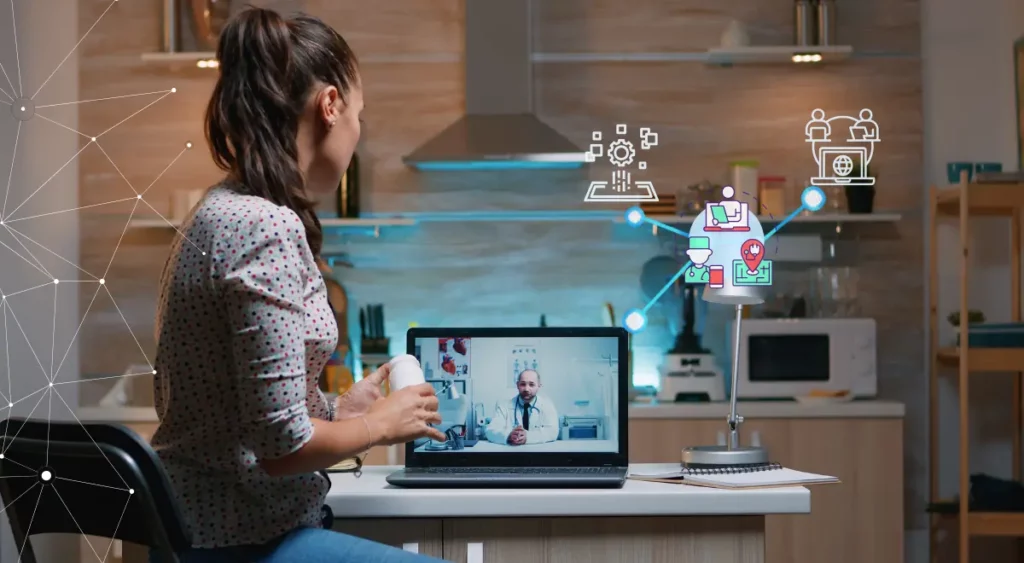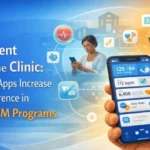Find the Best Remote Care Platform in 2026: HealthArc vs Competitors

For small practices and care providers, remote care solutions are highly effective in boosting revenue, improving outcomes, and reducing burnout amongst staff. However, a lack of adequate knowledge or a trustworthy partner for the integration of RPM and other technologies halts their progress towards scaling their remote services. HealthArc emerges as a powerful ally, a trusted name, and a unified chronic care management platform.
With a wide range of services to offer, such as Remote Patient Monitoring (RPM), Chronic Care Management (CCM), Medication Therapy Management (MTM), and more, HealthArc is the name you can bank on to expand your care services with significant ease.
However, comparing with multiple RPM and care service vendors in the market, where does HealthArc stand?
In this detailed guide, we’ll explore the differences between HealthArc’s services and other remote care service providers. By the end of this article, you’ll be able to choose a platform that’s robust, cost-effective, and can help you successfully scale your care operations. Let’s dive in.
Table of Contents
ToggleWhat Is HealthArc’s Market Position in 2026?
To begin with, let us uncover details like client base and market focus of several chronic care management platforms.
| Company | Market Focus | Clients Assisted |
|---|---|---|
| HealthArc | Unified chronic care | Small to mid-sized practices |
| HealthSnap | Enterprise virtual care | ACOs, IDNs, large orgs |
| Cadence | APP-led RPM | Protocol-driven health systems |
| HRS | Telehealth + RPM | Hospitals, home health |
| AccuHealth | Turnkey 24/7 monitoring | Clinics preferring hands-off models |
| CoachCare | Virtual health suite | Wellness, weight loss clinics |
As a frontiersperson in plug-and-play systems that support scalability, HealthArc focuses on value-based outcomes. Our services cater to the needs of small practices that do not have in-house tech support or billing teams. Our services offer thorough support in integration, implementation, training, billing, and troubleshooting, making remote care integration seamless for small providers.
How Do Core Services Compare Across Platforms?
Below is a detailed comparison of the services offered by HealthArc and other market players.
Why Does Remote Patient Monitoring Differ Across Vendors?
HealthArc features FDA-approved, cellular-enabled devices.
Why Our Technology Stands Out
Our platform is easy to deploy, integrates seamlessly with your EHR, and automates patient data collection and alerts—helping clinicians spend less time on administration and more time with patients.
- HealthSnap- HealthSnap offers great RPM services, which are exclusively beneficial for enterprise RPM + CCM. However, it demands complex EHR setups, making integration difficult.
- Cadence- With strong protocol-based outcomes, technology at Cadence offers strict compliance. The flexibility level, however, is limited, leading to a lesser scope of customization.
- HRS- Health Recover Solutions offers KLAS-rated devices with great analytics. Again, these services are best suited for hospitals or large clinical setups that can afford complex tech integration.
- AccuHealth- With a robust assortment of turnkey, artificial intelligence, and devices, AccuHealth offers a complete package. But the lack of personalization is something to worry about, as it may impact patient engagement and other key metrics.
- CoachCare- CoachCare is well-known for its fast RPM onboarding, combined with less focus on clinical-grade monitoring that might leave small practices hanging.
How Do CCM and PCM Features Vary?
- Embedded with automated care plans and a unified dashboard for both CCM and PCM, HealthArc enables streamlined billing and reporting.
- Health Recovery Solutions and HealthSnap provider broad support, but their platforms may overwhelm smaller practices.
- Cadence lacks distinct Chronic Care Management services.
Does Every RPM Platform Offer Remote Therapeutic Monitoring (RTM)?
Remote Therapeutic Monitoring (RTM): Contrary to other providers, HealthArc includes RTM support with sensors, SaMD, and assessments (PHQ-9, GAD-7). This enables smooth and compliant billing across therapy lines for care providers. This feature is often missing or limited in competitors like CoachCare or AccuHealth.
What Types of Clinical Support Models Are Available?
HealthArc offers extensive flexibility that becomes a major strength for small practices. It has a SaaS model for those who want to manage patient monitoring in-house and a full-service clinical support option for practices who want to offload daily operations. With this dual approach, practices can scale services based on staffing and capacity.
- AccuHealth delivers 24×7 full-service clinical monitoring ideal for completely hands-off providers. However, this may not suit clinics that want to enhance patient relationships and control over treatment plans.
- Candence operates with an APP-led care team model. While it is effective in reducing patient escalations, it demands specialized clinical roles and medical infrastructure which small clinics often lack.
- HealthSnap and HRS come with strong automation workflows. However, implementing them in lean environments is difficult, as they are built for large enterprise teams with built-in IT and clinical operations departments.
When we focus on the facet of clinical support, HealthArc comes forth as the best alternative with intuitive dashboards, automation, customizable care team roles, and clinical workflows that support small to medium practices.
How Seamless Is Technology and EHR Integration?
HealthArc is constructed with deep HL7 and FHIR integration capabilities. This promotes smooth synchronization with leading EHRs and reduces discord in routine operations. Features like real-time alerts, auto-tracking of vitals, and built-in billing analytics prompt providers to manage each remote monitoring task from a one dashboard. Let’s compare this to other providers.
- HealthSnap boasts compatibility with more than 80 Electronic Health Record systems. However, the setup and deployment process are complicated and demands extensive resources. Thus, it is better suited for large hospitals and healthcare facilities.
- HRS comes with an advanced analytics suite demanding resolute onboarding and reporting teams. Thus, small providers find it difficult to sustain on this technology.
- AccuHealth harbours AI-enhanced dashboards with fast deployment. However, the level of customization is limited to their service model.
- CoachCare backs virtual health automations and limited EHR connectivity. But it is designed for niche clinics and not for general primary care clinics.
Compared to these platforms, HealthArc offers a balance of powerful integrations without enterprise-grade complexity. Thus, small practices can easily adopt our platform.
What Clinical Outcomes Can Providers Expect?
Providers like Cadence and HRS publish impressive case studies, highlighting impressive results with their partnership. Cadence recently promoted a 50% reduction in hypertension patients. HRS boasted 7% 30-day admission rate, which is huge. However, their results are tied to large-scale pilot programs and hospital collaborations, and these results are often not applicable to small providers.
HealthArc provides practical benefits for small and medium care providers. Providers generally experience results like faster billing cycles, fewer patient no-shows, better adherence amongst patients, and reduced burnout amongst staff. These outcomes are substantial for small providers as they directly impact revenue and care quality. We understand that small teams cannot afford delays or inefficiencies. Therefore, our outcomes can be found in everyday operational improvement and not just supervised trials.
How Do Vendors Handle Reimbursement and Billing?
A common roadblock experienced by small providers is billing compliance and reimbursement optimization. These account for the core strengths of HealthArc. Our platform offers built-in CPT code logic for RPM, RTM, CCM, MTM, and other remote monitoring and disease management services. We help providers minimize billing errors so that they can maximize their revenue without hiring specialists for billing and compliance.
In comparison, HRS offers detailed billing documentation and training guides. HealthSnap has robust CMS policy insights to support back-office coding teams. AccuHealth supports billing through audit trails and time-stamped logs, if you rely on their system.
However, no one offers all-in-one billing automation like HealthArc. With our services, solo and small practices become capable of handling complex reimbursement codes confidently.
How Do Platforms Compare on Patient Engagement?
At HealthArc, patient engagement is always at the forefront of our services. Our multi-channel support system combines SMS, phone, mobile app, and video-based check-ins to offer comprehensive care. Automated health alerts, educational resources, symptom tracking, and timely follow-ups accompany our platforms. Consequently, providers can witness an increase in compliance and patient satisfaction.
While HRS and CoachCare offer great tools for engagement, their app-based tools often require custom configuration or platform-specific workflows. This increases setup time and confusion.
HealthArc features plug-and-play tools that are designed to help tech-savvy and non-tech-savvy patients. They improve engagement and participation, reduce onboarding friction, and increase usage rates, especially in the case of the elderly and chronic care populations.
Boosting Patient Engagement with Remote Patient Monitoring
What Should Providers Expect During Deployment and Implementation?
Small providers often struggle with time constraints and a lack of multiple staff members. Thus, HealthArc comes with a streamlined onboarding experience. Our platform ensures minimal disruption, set timelines, and hands-on deployment support for providers choosing SaaS or full-service.
CoachCare offers a two-week setup period, while AccuHealth guarantees a setup that goes live within 24 hours. However, these are based on fixed workflows or turnkey models that require little or no customization.
At HealthArc, our rollout plans are tailors to providers’ needs. They are extremely advantageous for providers who want to integrate services into existing care processes without disruption.
Which Vendor Offers the Most Transparent Pricing?
Pricing and cost structure is amongst the most important features when choosing the right remote care platform. HealthArc has an extremely attractive feature for small practices– a zero-upfront fee model. This is accompanied by flexible pricing options based on SaaS or full-service preference. Providers can also choose from bundled device models or bring-your-own-device (BYOD) setups. This customizable structure reduces capital investment and makes it easier for small providers to get started.
Vendors like CoachCare or AccuHealth often work on bundled models. These generally include hidden service fees, minimum volume commitments, and lack transparent pricing structures.
HealthArc has a transparent, scalable pricing structure that allows small clinics, solo practitioners, and growing practices to integrate digital care solutions without putting a hole in their pockets.
Book a Consultation for FREE
| Factor | HealthArc | HealthSnap | Cadence | HRS | AccuHealth | CoachCare |
|---|---|---|---|---|---|---|
| Core Services | RPM, RTM, CCM, PCM, TCM, BHI | RPM, CCM | RPM | RPM, CCM, BHI | RPM, CCM | RPM, virtual health |
| Devices | FDA, cellular, HL7/FHIR | 80+ EHRs | Protocol RPM | KLAS rated dash-boards | AI, 24/7 setup | Fast integration |
| Staffing | SaaS/full-service | Platform only | APP-led | Staffing support | Clinical extension | Coordinator help |
| Billing | Built-in CPT logic | CMS expertise | Limited CPT scope | Billing tools | Audit trails | Claims optimization |
| Outcomes | High adherence, efficiency | Value-
focused |
50% cost drop | 7% readmission | Patient-focused | Blended results |
| Deployment | Custom | Long setup | Protocol-led | Standard | 24 hrs | 2 weeks |
Competitor Deep-Dive: HealthArc vs Market Players
Here’s a summary of how HealthArc compares with other market players.
- HealthSnap: HealthSnap is a leading remote services provider with a focus on serving large healthcare systems such as enterprise-level partners. Healthcare systems like ACOs, IDNs, and others with a HITRUST-certified RPM+CCM platform can use HealthSnap’s services to scale services with their dedicated teams. HealthArc, on the other hand, offers the same level of clinical-grade RPM, CCM, and other services, but with a twist. These come with a plug-and-play setup with zero upfront investment, flexible pricing, and cellular-enabled FDA-approved devices. HealthArc’s services are best suited to small and mid-sized clinics that lack large operational teams and prefer faster onboarding.
- Cadence: With APP-led clinical models, Cadence takes a disease-specific, protocol-driven approach to remote monitoring. Its services show impressive data on conditions like hypertension and heart failure, but their offering is narrow and allows little or no customization. HealthArc supports a broader care ecosystem with services like RPM, CCM, RTM, BHI, TCM, and more under one platform. Small clinics and private practices looking for maximum billing flexibility can rely on HealthArc’s platform for diverse CPT coverage. Thus, HealthArc provides a more adaptable and cost-effective solution with no requirement for internal APP teams.
- Health Recovery Solutions (HRS): HRS is known for its award-winning telehealth and RPM technology. According to KLAS ratings, it is a popular choice amongst large hospitals. Its analytics and reimbursement tools are great, but their implementation is complex and better suited for hospitals with dedicated staff. In contrast, HealthArc offers an immediate and effective solution, offering RPM, RTM, and care management services in one dashboard. HealthArc’s solution has HL7/FHIR integration and pre-configured CPT billing tools, which eradicate complexity and ensure quick returns.
- AccuHealth: AccuHealth offers a 24/7 fully managed RPM service ingrained with clinical monitoring, AI alerts, and quick deployment. It is ideal for providers seeking a hands-off model, but it lacks control and customization. In contrast, HealthArc offers a more flexible model in both SaaS and full-service variants that offer complete transparency. It includes RTM, BHI, TCM, and other services under one umbrella. It is best suited for small practices that want control, modular services, and deeper integration with their clinical workflow.
- CoachCare: CoachCare offers exclusive services focused on weight loss clinics, wellness centres, and speciality care. It integrates virtual care with RPM and provides services like rapid onboarding and optimized billing. Their strength, however, lies in virtual health coaching, but they can’t offer multiple services under one roof. HealthArc’s full CPT code coverage, including RTM and behavioural health, makes it more attractive for care providers. The clinical-grade device suite without the complexity of implementation makes HealthArc more suitable for primary care, internal medicine, and speciality clinics. It helps providers run a healthcare-first platform with scalable reimbursement.
Key takeaways
- HealthArc is built for small and mid-sized practices, unlike many enterprise-only competitors.
- Offers RPM, CCM, PCM, RTM, BHI, TCM in one unified platform.
- Built-in CPT code logic simplifies billing and compliance.
- Plug-and-play, FDA-approved devices ensure fast adoption.
- Flexible SaaS + full-service options allow practices to scale.
- Transparent, zero-upfront pricing makes HealthArc affordable.
Frequently Asked Questions (FAQs)
HealthArc’s services are designed for small and mid-sized practices. It has a unified platform that covers RPM, CCM, PCM, TCM, and other remote monitoring and care services.
Yes, HealthArc is amongst the few platforms that provide advanced RTM support. It enables providers to adhere to tracking via sensors with self-reporting tools and support for CPT codes.
HealthArc has a built-in billing logic. It supports the latest CPT codes for all chronic care services, such as RPM, CCM, RTM, etc. HealthArc’s services automate documentation, time tracking, and compliance for the providers.
HealthArc allows providers to choose from flexible onboarding options like Software-as-a-Service or end-to-end deployment. Based on the service opted, clinics can go live with the services within a few days, with training, device setup, and EHR integration that HealthArc’s team handles.
HealthArc has in-store plug-and-play devices which the FDA approves. These are cellular-enabled and offer great services for monitoring blood pressure, glucose, weight, and more. Providers can integrate these tools into their routine workflow for real-time alerts and continuous patient monitoring.
AccuHealth offers fully managed 24/7 monitoring but limits provider control. HealthArc gives providers flexibility with SaaS or full-service models and customizable care plans.
HealthArc’s remote patient monitoring platform offers adaptable clinical software to tailor care for diverse patient needs — learn more here: Benefits of Remote Patient Monitoring Software For Healthcare Providers.
Conclusion
HealthArc combines the best of all worlds– you get flexibility, CPT coverage, patient engagement, and billing simplicity together like never before. Tailored for small clinics and providers, HealthArc’s solutions help you get powerful results without enterprise-level overhead. Our services help care teams stay connected with patients and offer personalized services with significant ease. This makes it the perfect platform for small and mid-sized clinics and care providers, and even big healthcare setups to improve patient outcomes and earn more reimbursement.
Schedule a counselling session with HealthArc’s expert team to learn more.
Most Recent Blogs
Categories
Related Blog
- December 24, 2025 | Read Time: 7 mins
What Is Patient-Centered Care? Benefits, Key Principles, and Real-World Examples
Patient-centered care is one of the most important ideas shaping how healthcare...
Learn More- December 19, 2025 | Read Time: 12 mins
Engagement Beyond the Clinic: How Mobile Apps Increase Patient Adherence in RPM and RTM Programs
Through the introduction of Remote Patient Monitoring (RPM) and Remote Therapeutic Monitoring...
Learn More- December 15, 2025 | Read Time: 10 mins
G2211 CPT Code: Complete Description, Billing Guidelines & Reimbursement
G2211 CPT code is an add-on HCPCS code that lets you capture...
Learn More


